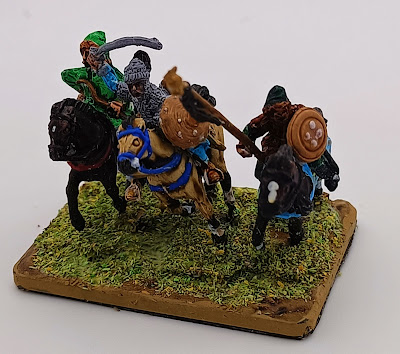The best way to showcase a newly painted army is to display it on the table, and that's exactly what I did. I utilized one of the scenarios from the By Fire and Sword supplement, specifically Warsaw 1656. Although this supplement was originally designed for the game's first edition, I made some modifications to adapt it for the second edition. This allowed us to play using the new rules. The scenario we played was number four, which details the Lithuanian-Tatar attack on the Brandenburg positions on July 29, 1656.
UMPIRING: Bartek Żynda
1. Forces.
When preparing the army lists, I began by taking the number of bases from the original scenario and then converted them to match the new unit sizes. For the Tartars, I borrowed units from the Lithuanian Tartars and used them to create an Elite Tartar cavalry.
 |
| Tatars |
 |
| Lithuanians |
COLONEL (2 orders)MAJOR (1 order)2 x MERCENARY INFANTRY (M)1 x MUSKEETER SQUADRON (S)2 x DRAGOONS (S)1 x LIGHT CANON BATTERY (S)
COLONEL (2 orders)MAJOR (1 order)1 x VETERAN REITERS (M) (Veterans)1 x REITERS (M)1 x ARMOURED REITERS (S)
2. The Game.
The Brandenburgers were the first to deploy their units, followed by the Tatars. After that, I gave the Lithuanians an opportunity to deploy. They could do this by sacrificing their colonel's orders. They would roll a die and if they sacrificed one order, they would enter on a roll of 1, if two, then on the roll of 2, and so on. However, these sacrificed orders could not be used during their first turn on the board. This meant that even if they faced failure, the Colonel would have fewer actions available. Ultimately, Michael chose not to sacrifice any orders and decided to enter the game on the second turn. He had his chance...
The first round began with the Tatars launching a massive barrage of arrows at the Brandenburg positions, which proved to be highly effective. In response, two units of Brandenburg cavalry—comprising veterans and armoured troops—charged at the Tatars. They successfully pushed back the Tatars with Spears and one unit of the regular Tatars. However, the veterans sustained heavy casualties and were forced to retreat to the dunes to regroup. Shortly thereafter, the Lithuanians arrived on the scene.
The Lithuanians, accompanied by their dragoons, approached the Brandenburg positions but were met with a volley of muskets, resulting in the loss of one Dragoon unit. Subsequently, the Lithuanian cavalry took the lead, charging at the Germans. They successfully destroyed a Musketeer Squadron and the Dragoons; however, their charge against the pikemen failed, forcing the Cossack Style Cavalry to retreat.
The situation was different for the Brandenburg cavalrymen, who faced attack from two units of Cossack cavalry. They managed to repel both charges, suffering only minor losses in the process. On the other flank, the Tatars continued to use their bows effectively, striking their opponents from a distance, even managing to shoot a cannon crew. However, they were eventually forced to retreat when met with another volley of muskets.
Ultimately, the Brandenburgers held the crucial hill and emerged victorious in this scenario.
 |
| Lithuanian-Tartar loses. |
 |
| Bandenburgian loses. |
3. Links.
SESWC:
to be updated soon...
FLICKR:
https://www.flickr.com/photos/asienieboje/albums/72177720322138516/













































